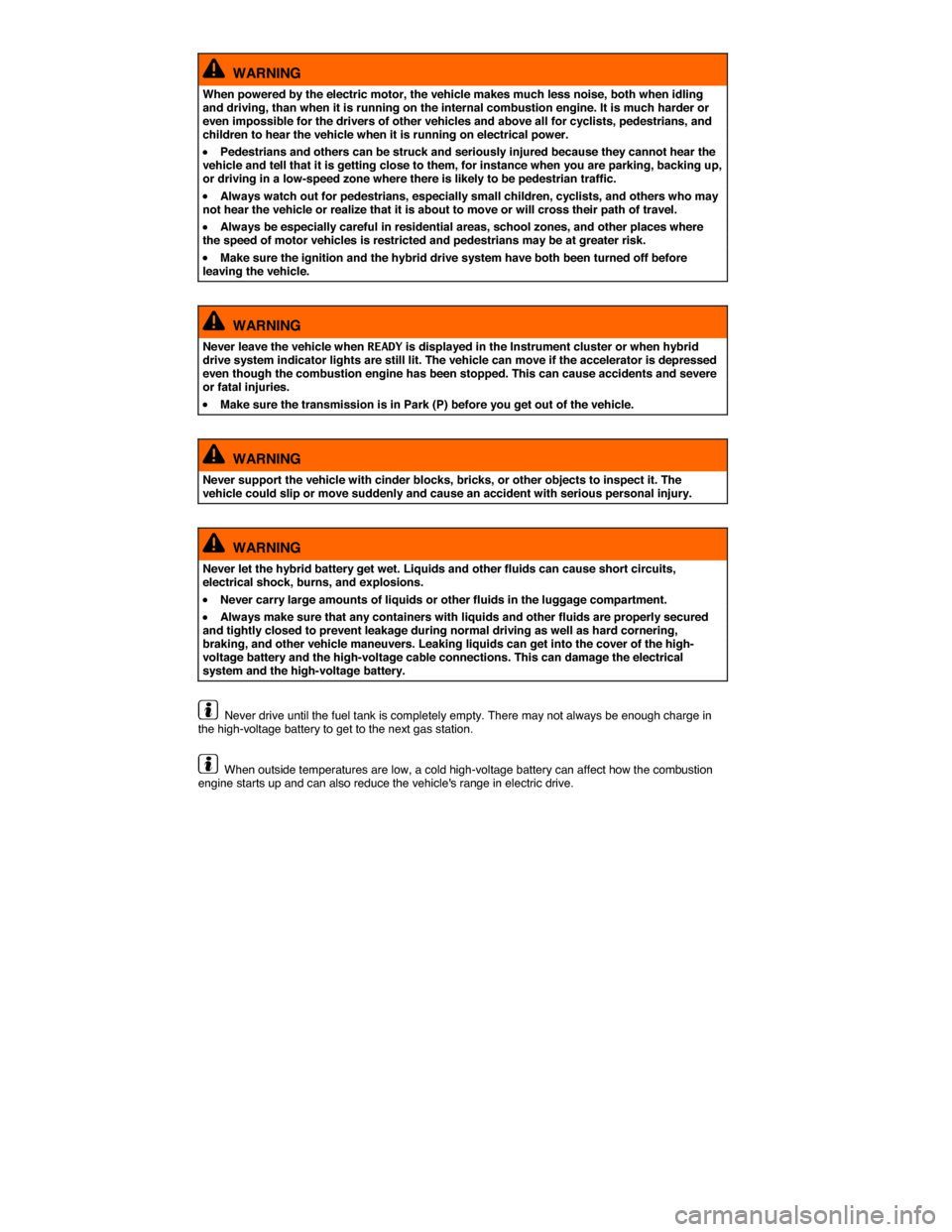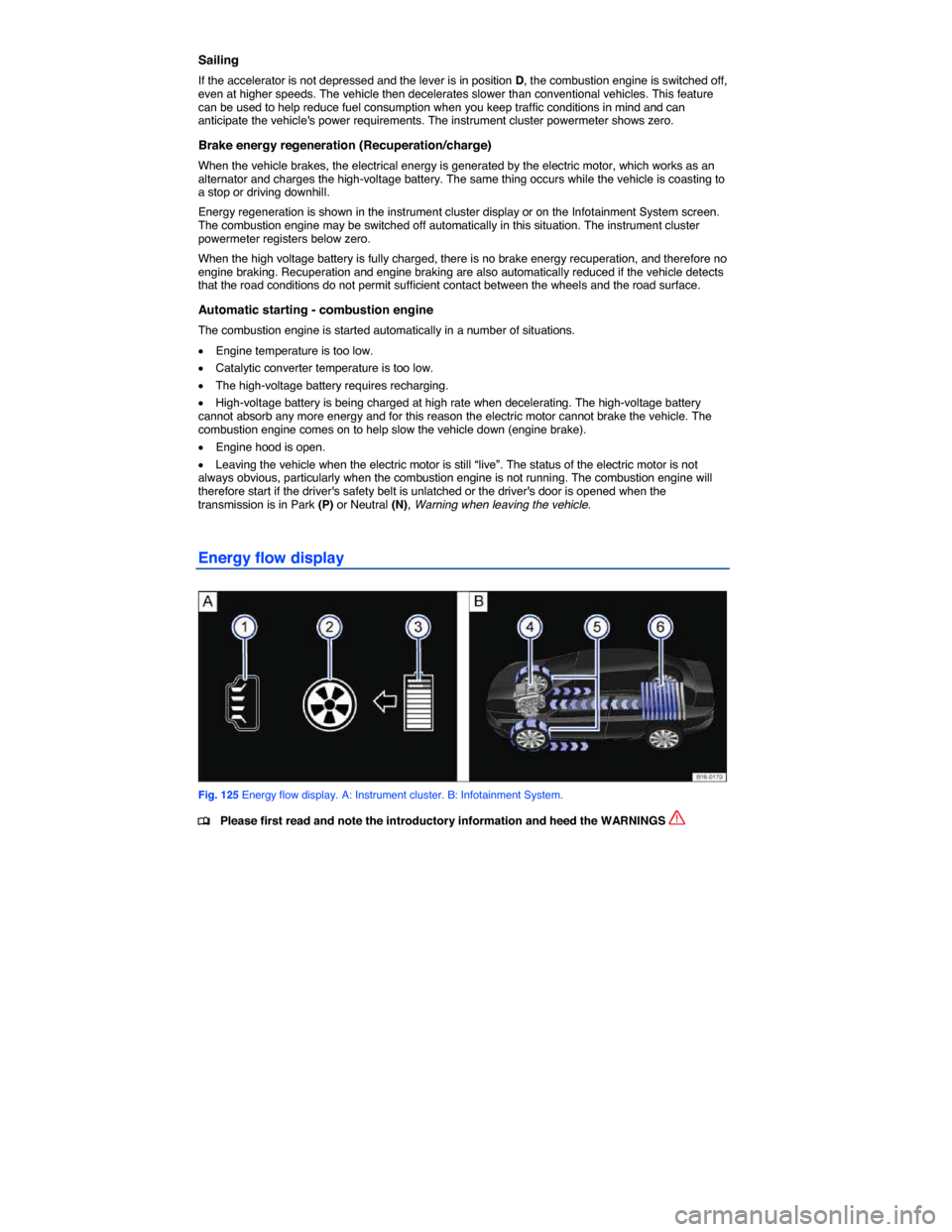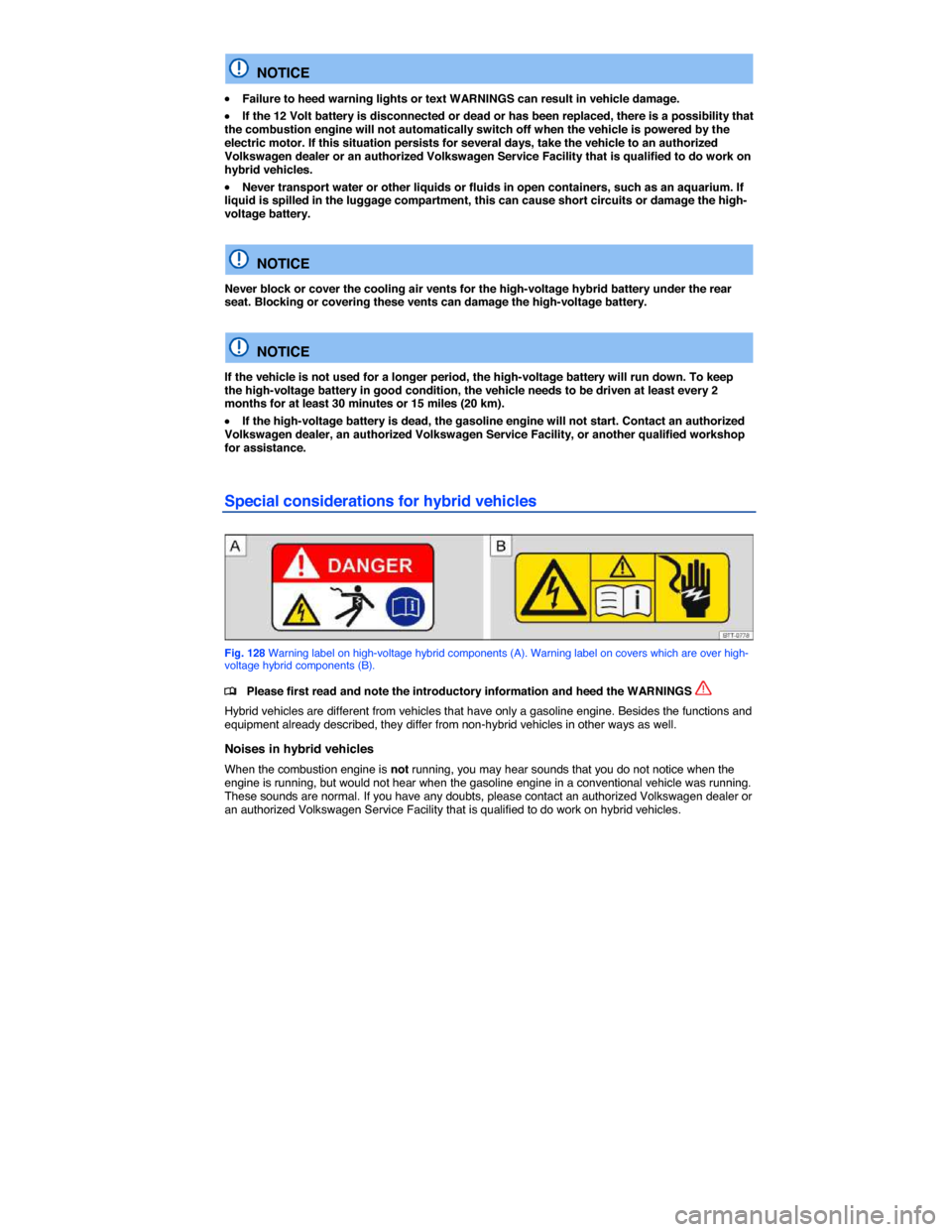2014 VOLKSWAGEN JETTA HYBRID Motor not start
[x] Cancel search: Motor not startPage 182 of 372

Please perform these steps only in the order listed.
Step Vehicles without Keyless AccessVehicles with Keyless Access
6. Removing the vehicle key from the ignition switches off electrical equipment and activates the steering column lock.
Opening the doors switches off electrical equipment and activates the steering column lock.
WARNING
Never stop the engine before the vehicle has come to a complete stop. You can lose control of the vehicle, crash, and be seriously injured.
�x The airbags and safety belt pretensioners will not work when the ignition is switched off.
�x The brake booster does not work when both the combustion engine and electric motor are switched off. More brake pedal pressure will be needed to stop the vehicle.
�x The power steering system does not work when both the combustion engine and electric motor are switched off, and you will need more force to steer the vehicle.
�x When the key is removed from the ignition switch, the steering will lock and you will not be able to steer the vehicle.
NOTICE
If the vehicle has been driven hard for a long time, the engine could overheat when it is stopped. To reduce the risk of engine damage, let the engine idle in Neutral for about 2 minutes before you switch off the ignition.
If the ignition is switched on or the engine is running and the driver door is opened, a chime sounds. The chime is also a reminder to switch off the engine and turn off the ignition before leaving and locking the vehicle from the outside.
On vehicles with automatic transmissions, the vehicle key can only be removed from the ignition when the transmission is in Park (P).
After the engine has been switched off, the radiator fan in the engine compartment may keep running for several minutes, or may start running after the vehicle has been parked for a while, even if the ignition is switched off and the vehicle key has been removed. The radiator fan shuts off automatically when the engine has cooled down enough.
Electronic immobilizer
�
Page 214 of 372

WARNING
When powered by the electric motor, the vehicle makes much less noise, both when idling and driving, than when it is running on the internal combustion engine. It is much harder or even impossible for the drivers of other vehicles and above all for cyclists, pedestrians, and children to hear the vehicle when it is running on electrical power.
�x Pedestrians and others can be struck and seriously injured because they cannot hear the vehicle and tell that it is getting close to them, for instance when you are parking, backing up, or driving in a low-speed zone where there is likely to be pedestrian traffic.
�x Always watch out for pedestrians, especially small children, cyclists, and others who may not hear the vehicle or realize that it is about to move or will cross their path of travel.
�x Always be especially careful in residential areas, school zones, and other places where the speed of motor vehicles is restricted and pedestrians may be at greater risk.
�x Make sure the ignition and the hybrid drive system have both been turned off before leaving the vehicle.
WARNING
Never leave the vehicle when READY is displayed in the Instrument cluster or when hybrid drive system indicator lights are still lit. The vehicle can move if the accelerator is depressed even though the combustion engine has been stopped. This can cause accidents and severe or fatal injuries.
�x Make sure the transmission is in Park (P) before you get out of the vehicle.
WARNING
Never support the vehicle with cinder blocks, bricks, or other objects to inspect it. The vehicle could slip or move suddenly and cause an accident with serious personal injury.
WARNING
Never let the hybrid battery get wet. Liquids and other fluids can cause short circuits, electrical shock, burns, and explosions.
�x Never carry large amounts of liquids or other fluids in the luggage compartment.
�x Always make sure that any containers with liquids and other fluids are properly secured and tightly closed to prevent leakage during normal driving as well as hard cornering, braking, and other vehicle maneuvers. Leaking liquids can get into the cover of the high-voltage battery and the high-voltage cable connections. This can damage the electrical system and the high-voltage battery.
Never drive until the fuel tank is completely empty. There may not always be enough charge in the high-voltage battery to get to the next gas station.
When outside temperatures are low, a cold high-voltage battery can affect how the combustion engine starts up and can also reduce the vehicle's range in electric drive.
Page 220 of 372

Sailing
If the accelerator is not depressed and the lever is in position D, the combustion engine is switched off, even at higher speeds. The vehicle then decelerates slower than conventional vehicles. This feature can be used to help reduce fuel consumption when you keep traffic conditions in mind and can anticipate the vehicle's power requirements. The instrument cluster powermeter shows zero.
Brake energy regeneration (Recuperation/charge)
When the vehicle brakes, the electrical energy is generated by the electric motor, which works as an alternator and charges the high-voltage battery. The same thing occurs while the vehicle is coasting to a stop or driving downhill.
Energy regeneration is shown in the instrument cluster display or on the Infotainment System screen. The combustion engine may be switched off automatically in this situation. The instrument cluster powermeter registers below zero.
When the high voltage battery is fully charged, there is no brake energy recuperation, and therefore no engine braking. Recuperation and engine braking are also automatically reduced if the vehicle detects that the road conditions do not permit sufficient contact between the wheels and the road surface.
Automatic starting - combustion engine
The combustion engine is started automatically in a number of situations.
�x Engine temperature is too low.
�x Catalytic converter temperature is too low.
�x The high-voltage battery requires recharging.
�x High-voltage battery is being charged at high rate when decelerating. The high-voltage battery cannot absorb any more energy and for this reason the electric motor cannot brake the vehicle. The combustion engine comes on to help slow the vehicle down (engine brake).
�x Engine hood is open.
�x Leaving the vehicle when the electric motor is still “live”. The status of the electric motor is not always obvious, particularly when the combustion engine is not running. The combustion engine will therefore start if the driver's safety belt is unlatched or the driver's door is opened when the transmission is in Park (P) or Neutral (N), Warning when leaving the vehicle.
Energy flow display
Fig. 125 Energy flow display. A: Instrument cluster. B: Infotainment System.
�
Page 223 of 372

NOTICE
�x Failure to heed warning lights or text WARNINGS can result in vehicle damage.
�x If the 12 Volt battery is disconnected or dead or has been replaced, there is a possibility that the combustion engine will not automatically switch off when the vehicle is powered by the electric motor. If this situation persists for several days, take the vehicle to an authorized Volkswagen dealer or an authorized Volkswagen Service Facility that is qualified to do work on hybrid vehicles.
�x Never transport water or other liquids or fluids in open containers, such as an aquarium. If liquid is spilled in the luggage compartment, this can cause short circuits or damage the high-voltage battery.
NOTICE
Never block or cover the cooling air vents for the high-voltage hybrid battery under the rear seat. Blocking or covering these vents can damage the high-voltage battery.
NOTICE
If the vehicle is not used for a longer period, the high-voltage battery will run down. To keep the high-voltage battery in good condition, the vehicle needs to be driven at least every 2 months for at least 30 minutes or 15 miles (20 km).
�x If the high-voltage battery is dead, the gasoline engine will not start. Contact an authorized Volkswagen dealer, an authorized Volkswagen Service Facility, or another qualified workshop for assistance.
Special considerations for hybrid vehicles
Fig. 128 Warning label on high-voltage hybrid components (A). Warning label on covers which are over high-voltage hybrid components (B).
�
Page 257 of 372

WARNING
The engine compartment of any motor vehicle is a potentially dangerous area and can cause serious personal injury.
�x Always use extreme caution when doing any work in the engine compartment. Always follow commonly accepted safety practices and use common sense. Never risk personal injury.
�x Never perform any work in the engine compartment unless you know exactly how to carry out the job and have the correct technical information and the correct tools.
�x If you are uncertain about what to do, have the work performed by an authorized Volkswagen dealer, an authorized Volkswagen Service Facility, or another qualified workshop. Serious personal injury may result from improperly performed work.
�x We strongly recommend that you always have HID – High Intensity Discharge (Xenon) headlights and H7 bulbs replaced by a qualified technician. Serious personal injury may result from improperly performed work.
�x Never open or close the engine hood if steam or coolant is escaping. Hot steam or coolant can cause serious burns. Always wait until you no longer see or hear steam or coolant escaping from the engine.
�x Always let the engine cool down completely before carefully opening the hood.
�x Hot parts of the engine and the exhaust system will burn skin on contact.
�x When the engine has cooled down and you are ready to open the hood:
– Firmly apply the parking brake and shift the transmission into Park (P).
– Take the vehicle key out of the ignition.
– On vehicles with Keyless Access, make sure that the remote control vehicle key is out of range of the vehicle and that the vehicle cannot be started by depressing the starter button, Starter button.
– Always keep children and others away from the engine compartment and never leave them unsupervised.
�x The engine coolant system is under pressure when the engine is hot. Never unscrew the coolant expansion tank cap when the engine is hot. Hot coolant can spray out and cause severe burns and other serious injuries.
– Turn the cap slowly and very carefully in a counterclockwise direction while applying light downward pressure on the top of the cap.
– Always protect your face, hands, and arms from hot escaping coolant or steam by covering the cap with a large, thick rag.
�x Never spill fluids on the engine or exhaust system when refilling. Spilling fluids onto hot parts of the engine or exhaust system can cause a fire.
WARNING
High voltage systems in the engine compartment can cause electrical shocks or even electrocution, severe burns, other serious injuries, and even death!
�x Never short-circuit the electrical system. Be especially careful when using jumper cables. The vehicle's battery could explode!
�x To reduce the risk of electrical shock and personal injury while the engine is running or being started:
– Never touch ignition cables. Never touch other components of the high voltage electronic ignition system.
– Never touch the wiring of the HID – High Intensity Discharge (Xenon) headlights.
�x Read and heed the important information and warnings on cleaning the engine compartment, Cleaning the engine compartment.